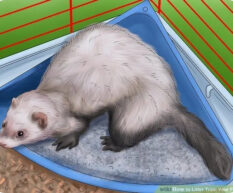Ferret News
Treating and preventing ear mites in ferrets
By Rose-Anne Meissner, PhD

Do my ears look dirty to you?
Image courtesy of Max Moreau
One of the less enjoyable aspects of pet ownership is treating your pets for parasites, such as fleas and ear mites. It’s important to keep an eye on your animals for these pests because they can cause intense itching and discomfort. Fortunately, both ferret fleas and ear mites can be treated effectively by topical or injectable medicines. In this article, we’ll focus on ear mites.
Ear mites are the common name for a species called Otodectes cynotis. These tiny arachnids can infest the ears of ferrets, dogs, and cats. (Generally, they don’t infest human ears.) In ferrets, ear mites cause itchy ears, and you might see an infected ferret shaking his head, scratching himself, rubbing his ears on the floor, or walking with his head tilted to one side. Your ferret might show some hair loss from scratching. Ferret ears normally produce wax that is light brown, orange, or reddish in color. But a mite infection can cause the wax to become reddish brown or even black. This wax may build up more quickly than normal, the texture may be crumbly, and it can have an unpleasant odor. Erika Matulich recalls that when she brought one of her ferrets home, she noticed a stinky smell from her ferret’s head. She kept giving poor Critter baths until she finally realized the smell was coming from Critter’s ear wax! (Note: Be aware of bathing your ferret too much, as this can dry out their skin and cause the skin to ramp up its production of oils. This is uncomfortable for them and will also often make them smell more.)
How dangerous are ear mite infections?
Besides the discomfort of itchy ears, ear mites can pose a more significant threat to your ferret’s health. Most mite infections are localized within the outer ear (the visible part of your ferret’s ears), but more serious infections can cause the eardrum to burst or an infection to break out in the middle and/or inner ear. Ear mites can also migrate out of the ear to infect the head and body. Migrated mites will burrow into the skin, which causes irritation.
How is a mite infection confirmed?
As with all ferret health issues, take your ferret to the vet if you think she has ear mites. Ear mites are very small, about half a millimeter in length. Sometimes they can be seen by the naked eye as tiny white moving dots, but they are much easier to visualize under a microscope. Your vet can collect a wax sample from your ferret’s ear to look for mites under the microscope.
Treating your ferret for ear mites
For all the treatment options, it’s important to keep two things in mind. First, the ear mite’s life cycle is about three weeks, and treatments do not penetrate the egg. This means that you’ll want to treat your ferret for three weeks to ensure that all mite larvae and adults are eliminated by the medication. Second, ear mites are VERY contagious and can infect other ferrets, dogs, and cats. You’ll need to treat all the animals in the house at the same time to get rid of ear mites, even if the other animals have no signs of mites.
Your ferret has several options for treating ear mites, and as always, we recommend you follow your vet’s advice on which treatment is best for your fur family.
Ivermectin.
For ferrets with mild to moderate infections, drops of ivermectin can be applied to the ferret’s ears once a week for 2-3 weeks. Ivermectin is a medication used to treat a wide variety of parasites. You can do the treatment at home or have your vet do it. A ferret with a very severe case of ear mites may do better with ivermectin injections; your vet should be able to determine the best way to administer the medication. Ivermectin is not safe for pregnant or lactating ferrets, as it may cause birth defects. You may also want to treat the tip of your ferret’s tail, since ferrets often sleep with their tail next to their ears.
Selamectin (Revolution)
. Selamectin is sold commercially as Revolution and is a common treatment option for fleas. It can also be used to treat ear mites by applying a single dose to the ferret’s back and between the shoulder blades (just like you would apply it for flea treatment). D.S. Miller and colleagues used 45 mg dose of selamectin in a liquid volume of 0.75 ml. Your vet can offer recommendations on the appropriate dose for your ferret. One potential benefit to using selamectin instead of ivermectin is the ease of application. If applying a treatment to your ferret’s ears several times sounds nearly impossible, ivermectin might be too difficult to use. In that case, selamectin may be the best choice.
Regardless of which treatment you use, it would be smart to clean your ferret’s bedding each week to remove any stray mites which could reinfect her.
Can ear mites be prevented?
The best way to prevent ear mites is to clean your ferret’s ears regularly; every other week is a good frequency to use as a baseline. Be careful as you clean your ferret’s ears; they are sensitive!
There are at least two ways to clean ferret ears. The “direct swab method” involves using a cotton swab to apply a special solution, such as OtiClens (an ear cleaner for pets’ ears), to the ears. Use the swab to wipe out the crevices of the outer ear. You may need several swabs to adequately clean the various folds, but be sure to clean only the outer ear (the part you can see). Don’t push too deep with your swab or you risk damaging the middle and inner ear. (The principle is very similar to cleaning a human child’s ears; you want to clean the outer part only, so as to protect the delicate inside parts.)
The second method involves applying the liquid directly to your ferret’s ears. Apply 2-3 drops of warmed OtiClens to the ear (make sure it is warm, not hot) and massage the area behind the ear. Your ferret might respond by shaking her head, which is fine. You can then use a cotton swab to loosen and clean out any debris in the outer ear, again being careful not to push the swab into the ear too deeply.
You may need a second pair of hands to scruff your ferret during ear cleanings!
Further reading
Axelson, Rick. “Ferrets–Ear Mites.” VCA Hospitals. https://vcahospitals.com/know-your-pet/ferrets-ear-mites. Accessed 7 June 2019. (Web page)
Drakiotes, Alicia. “Tips on Cleaning Ferret Ears.” Petfinder. https://www.petfinder.com/pet-care/small-and-furry-care/tips-cleaning-ferret-ears/. Accessed 9 June 2019. (Web page)
“Ear Mites in Cats, Identification, Life Cycle, and Control. Christine DeMerchant’s Web Page. https://www.christinedemerchant.com/ear-mites-in-cats.html. Accessed 7 June 2019. (Web page)
“Ear Mites in Ferrets.” PetMD. https://www.petmd.com/ferret/conditions/ears/c_ft_ear_mites. Accessed 9 June 2019. (Web page)
“Ivermectin.” Wikipedia. Updated 28 May 2019. https://en.wikipedia.org/wiki/Ivermectin. Accessed 7 June 2019. (Web page)
Matulich, Erika. “Earmites.” Cypresskeep.com. http://www.cypresskeep.com/Ferretfiles/Earmites.htm. Accessed 7 June 2019. (Web page)
Miller, D.S. et al. “Efficacy and Safety of Selamectin in the Treatment of Otodectes cynotis Infestation in Domestic Ferrets.” The Veterinary Record, volume 159. Published in 2006. (Scholarly article)
“Mite.” Wikipedia. Updated 28 May 2019. https://en.wikipedia.org/wiki/Mite Accessed 7 June 2019. (Web page)
“Revolution for Cats & Dogs.” 1-800-PetMeds. https://www.1800petmeds.com/Revolution-prod10265.html. Accessed 9 June 2019. (Web page)




